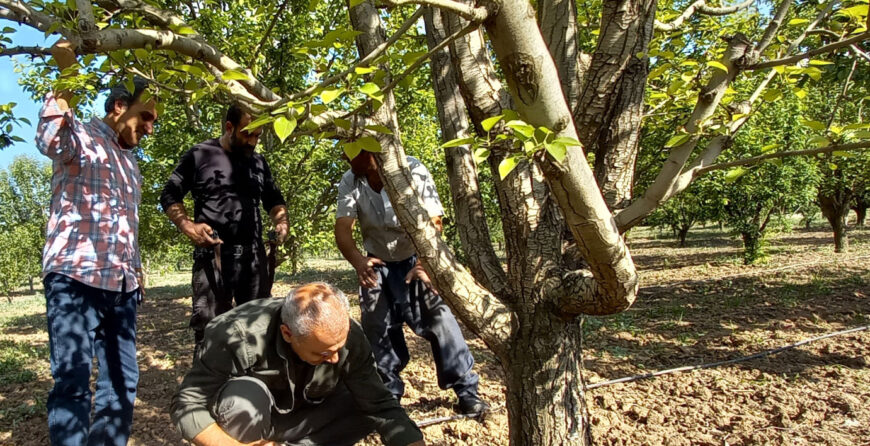This visit was carried out on 1401/02/19 to the gardens of Qadim Abad area located in Qazvin city by the team of technical managers and experts of Beniz Nahadeh Iranian Company.
Summary of garden tree problems:
Deterioration of pear trees as a result of crown and root rot, white root worm, psyllium and heavy soil texture
Crown and trunk rot disease
Crown and trunk rot disease signs:
– Reducing the number and size of leaves
– Drying of the branches on one side
– Green drying in the middle of growth at once
Reasons:
– Irrigation of the trunk of trees
– Pouring animal manure and soil under the tree trunks
– Heavy soil texture and lack of proper drainage
– The activity of soil fungi such as: Phytophtera, Fusarium and…
Prevention and treatment:
– Preventing water from reaching the trunk and irrigation in the shade
– Carrying out mulching in the shade and avoiding fertilizing under the trunk of the tree
– Covering the trunk from a depth of 10-15 cm under the soil to a height of 50 cm with materials (horticultural glue + protective fungicide + cypermethrin)
– In cases of decay: first remove the decayed tissues. Then cover the shaved area with the above materials. (In cases where the depth of decay is high, use fire for disinfection.)
– Planting seedlings on raised beds
– Guardianship for seedlings
– Proper drainage
Pear and apple rust disease
Apple and pear rust disease is a physiological disease that occurs in the region of fruit ripening due to several factors, the cuticle is thin and the epidermis is destroyed, and a brown corky and fluffy layer is formed on the surface of the fruit skin, which reduces the marketability. And the shelf life of yellow fruits like pears and apples.
reasons:– Continuous rain and dew- High relative humidity of the air- Strong increase in temperature and evaporation from the surface of the fruit- High consumption of copper and sulfur poisons- High consumption of nitrogen fertilizers
Prevention and treatment:
– Foliar spraying with SILINOX after petal fall (and repeat 2 weeks later)- Spraying with Kaptan and Mancozeb- Proper pruning and sufficient ventilation between the branches- Not planting varieties sensitive to rust- Avoiding excessive use of nitrogen fertilizers (decrease consumption in May)- Adequate consumption of phosphorus and spraying of liquid phosphorus (LIQUFOS) in the hazel stage- Avoiding heavy watering and reducing relative humidity
Fire blight disease:
Fire blight disease is caused by the bacterium Erwinia amylovora, which is most commonly seen on pears, pears, apples, and parsnips. The disease agent is spread by wind and insects, especially bees.
signs:
– Burning and drying of flowers, fruits and branches and development towards the bottom of the branch
– The exit of sap from affected tissues (fruits and branches)
Prevention and treatment:
– Not planting trees sensitive to Fire blight – Timely periodic sprayings (autumn, mid-flowering, after flowering)- Foliar spraying with SILINOX before and after flowering
Heavy soil texture
It prevents oxygen from reaching the roots, reducing the absorption of sufficient water and elements by the roots.
Signs:
– Reduced growth and small leaves and fruits- Muddy soil at a depth of 30 cm while the surface of the soil is dry.
Correction:
– Burying fertilizer in the shade of late autumn with plant residues (wood chips, straw, stubble), animal manure, sulfur fertilizers and sand- Light irrigation in shade- Use of humic acid (MEGAHUMATE)- Use of TRINOX organic potassium fertilizer- Proper drainage


